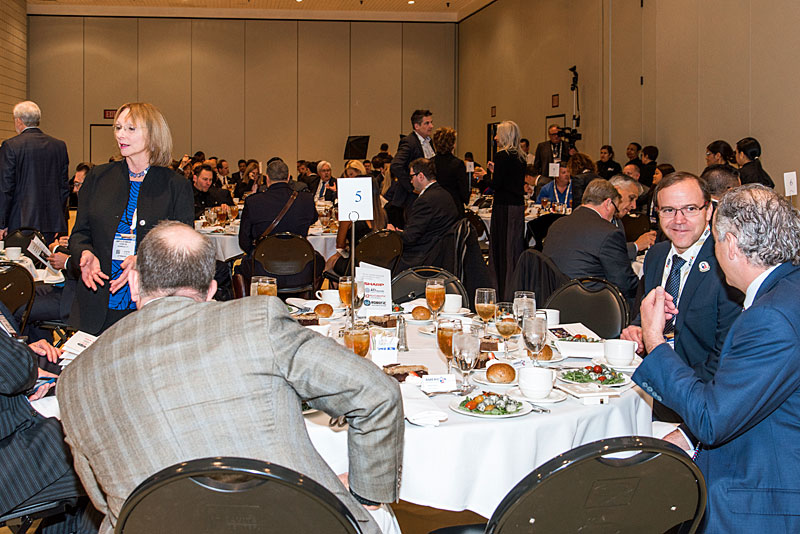Maritime security is one of the 17 major subjects for NATO, particularly with reference to the Mediterranean and the passage of immigrants and terrorists.
Increasing geopolitical tensions in maritime zones worldwide have created a strategic impetus to consider new platforms for identifying and responding to potential maritime threats as they become imminent.
There are 5 key question to address in the Maritime Security Sector.
1) How Can Non-Lethal Maritime Systems Deter Asymmetric Attacks?
- The prophylactic use of physical barriers has worked for many years.
- The Tirpitz and countless other examples showed just how effective these systems could be.
- Modern advances in materials and deployment means it allows security booms to be deployed and removed rapidly when not needed thus removing one of the main reasons barriers are not currently used in the vast majority of maritime security zones.
- They get in the way when not needed.
As well as long prophylactic barriers, just in time tactical barriers, that can be deployed in front of a moving target once it has been detected.
Effective Examples Include:
- resQmax
- Maritime Arresting Technologies Boatstopper, and
- For subsurface threats the Stingray net (unmanned underwater vehicles [UUV] interception net)
String ray nets
To address these concerns, Maritime Arresting Technologies has been working with the U.S. Navy under a cooperative research and development agreement (CRADA) to conceive and develop a system to successfully intercept underwater threats such as autonomous vessels and divers.
For instance, the Stingray Unmanned Underwater-Vessel (UUV) Interceptor. As UUV’s are increasingly recognized as potential threats to high value assets on or beside the water.
The Stingray UUV Interceptor System consists of a net that is rapidly deployable in front of a hostile UUV or other underwater threat (swimmer, self-propelled mine, etc.)

- The net is stored in a composite box that firmly attaches to the transom of a patrol boat.
- When the lid is opened it forms a chute that keeps the net clear of the drive units of the patrol boat and ensures that the net deploys without snags or twists
- The net provides protection across the entire water column, extending from the water surface to the seabed
- Constructed from mono-filament nylon it is practically invisible and therefore hard to avoid
- The net encapsulates the oncoming UUV, snagging on all and any projections
- Once captured the UUV can be towed away to be dealt with far from the target
Test Results
100% success result in trials at NUWC Newport when deployed into the path of a hostile UUV.
How it works?
- A drogue is deployed over the stern of a boat or other vessel including autonomous and remote control.

- The drogue catches in the water creating enough drag to pull the net from its storage bin as the deploying vessel continues forward.

- The initial drogue moves very little during deployment allowing the net to be precisely positioned.

- The deploying vessel can be travel at up to 20 knots during the deployment.

- The net self-sets due to the action of floater and sinker lines top and bottom.
Net Design
- The net is a cross between a Seine net (sea surface down) and a Gill net (sea bed up) and is intended to cover the entire water column.
- Nylon monofilament nets sink quicker than braided structures.
- Nylon netting is practically invisible underwater making evasion almost impossible.

- The net is fitted with a floating rope along the top edge and a lead core sinking rope to the bottom edge.
- This reduces snagging hazards associated with separate floats and weights.
- The net is made from 0.52mm nylon with a 7” stretch mesh.
- The net depth should be chosen for the specific area to be protected.
- GSA listings have been made for 200’ long nets in 10, 20, 30 and 40’ depth.
Anatomy of the Net

- The system can be deployed at speed, for the entire 200 foot length to stop threats in under ten seconds, protecting the entire water column from the surface to the seabed, for up to 40′ depth.
- The system keeps ports and harbors with high value assets, safe from underwater threats.
- The system can be deployed in under ten seconds protecting the entire water column from the surface to the seabed of 40′.
As sonars detect an object approaching a High Interest Vessel (HIV) or other high value asset, a patrol vessel manned or autonomous is rapidly deployed with the net to drop a protective screen in the water protecting the asset.
Once the target is caught a team can be brought in to safely dispose of it.
2) Determine Intent Before Escalating Levels of Force
- The vast majority of boaters are not a threat
- All actions beyond verbal commands are looked on as lethal force (by most law and order agencies).These include shouldering boats, shooting engines and warning shots
3) Determine if an Unknown UUV is Friend or Foe
- Crossing a visible, physical barrier provides the easiest means to determine intent.
4) Deter a Vessel that is determined to be Hostile
- The first step is to take energy out of the situation
- Engaging a vessel traveling at a high speed is dangerous to all parties and chaotic outcomes can easily happen
- The use of tactical boat stopping systems fits in easily with the escalation of force continuum and provides a means of removing risk from law enforcement operators and miscreants
- If a hostile vessel is slowed to walking pace or stopped entirely it is easier to board and take control of the situation.
For example, the Maritime Arresting Technologies Reel Mounted Security-Boom System
In addition, Maritime Arresting Technologies is the single-source provider of a revolutionary new reel mounted security-boom system which can close off the mouth of a harbor in under six minutes.
The system includes entanglement booms, which are both naturally buoyant and extremely strong.

- Security booms are stored on reels that can be either trailer mounted, boat mounted or housed in an ISO container.
- The 3 dimensional structure of the booms, entangle the propellers of encroaching vessels, bringing them to a rapid stop.
- Constructed from 8,000 lbs breaking strain Dyneema® rope, the boom is capable of jamming props of the most powerful motor boats.
- High visibility floats are positioned every 3’, to provide a visible barrier.
- Lengths of up to 1,500’ of this extremely lightweight security barrier is stored on an easily transportable compact reel.
- Multiple rows of entanglement boom can be used to provide scalable protection from single to multiple threats.
- A force multiplier allows a security vessel to deny access to 1,500’ of water.
Port of Tampa Bay – Waterway Security Enhancement Project
The Maritime Arresting Technologies reel mounted security-boom system was an integral part of the Port of Tampa Bay Security Enhancement Upgrade.
Since its implementation at Port Tampa Bay, the U.S. Coast Guard has confirmed that reel mounted security-boom system upgrade could in fact, reduce the port’s MSRAM Index.
Maritime Arresting Technologies seeks to assist the Nation’s ports, terminals, military and law enforcement agencies in more efficiently, and effectively responding to changes in MARSEC Levels.
(See in Action! Courtesy of Maritime Arresting Technologies and YouTube)
5) Maritime Arresting Technologies at a Glance
 Maritime Arresting Technologies designs, develop and manufacture systems that offer protection above and below the waves.
Maritime Arresting Technologies designs, develop and manufacture systems that offer protection above and below the waves.
Maritime Arresting Technologies produce lightweight reel-mounted security booms that can be deployed in minutes to provide physical protection and visual identification of a security zone (currently defined by imaginary lines.)
Their products also include tactical systems for boat stopping, disabling personal water craft and intercepting UUVs.
The 2017 ‘ASTORS’ Homeland Security Awards Program
American Security Today’s 2017 ‘ASTORS’ Homeland Awards Presentation Luncheon at ISC East was an overwhelming success, with distinguished guests from National, State and Local Governments, and Industry Leading Corporate Executives from companies allied to Government.
Over 100 professionals gathered from across North America and the Middle East to be honored from disciplines across the Security Industry in their respective fields which included:
- The Department of Homeland Security
- The Department of Justice
- The Security Exchange Commission
- State and Municipal Law Enforcement Agencies, and
- Leaders in Private Security

Recognized for their Innovative Training and Education Programs, Outstanding Product Development Achievements and Exciting New Technologies to address the growing Homeland Security Threats our Nation is facing.
America’s Security
American Security Today was formed after careful reflection of 9/11 and its aftermath when the Department of Homeland Security was established and there was an immediate explosion of new products and solutions for what was perceived as an imminent second attack on primary targets in the United States.
As time moved forward from 9/11 itself and in recent years, the threats to our nation have evolved from a large scale 9/11 type attack to:
- Domestic and International Terrorist Attacks carried out by ‘lone wolves’ and coordinated individuals
- Cybersecurity breach attacks against our government agencies, financial institutions and critical infrastructure facilities
- Unprecedented urban violence
- Cultural shifts and societal media bias, which make it increasingly difficult to secure our nation in this constantly evolving threat environment.

These current circumstances have put forward another rapid expansion of new ideas, products and solutions to combat these ever changing challenges.
These changes have called for a new generation of security experts in the Homeland Security and Public Safety fields who need real time knowledge of our ever growing threats.
These experts include the Government at the Federal, State and Local levels as well as from Private Firms specializing in Physical Security, Port Security, Law Enforcement, First Responders, Military and Private Security responsible for implementing coordinated security measures to ensure our Nation’s Security and improve Public Safety.
Together, each of these entities work together seamlessly on the front lines of protecting our communities, to ‘Keep our Nation Secure, One City at a Time.’
Disclaimer: This video is intended for informational purpose only. This may not be construed as a news item or advice of any sort. Please consult the experts in that field for the authenticity of the presentations.
Did you subscribe for our daily newsletter?
It’s Free! Click here to Subscribe!
Source: American Security Today




















